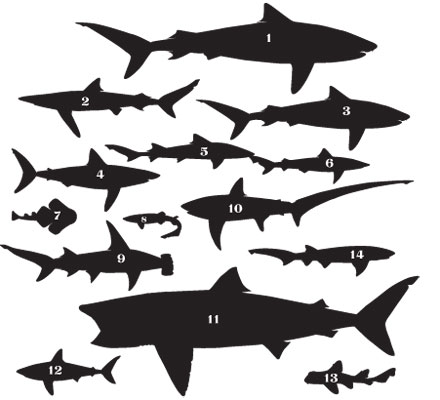Sharks of the Channel

1. Great White: Reach more than 20 feet in length and weigh up to 5,000 pounds, and often get as wide as a Volkswagen bus. World’s largest known predatory fish.
2. Blue Shark: Reach up to 13 feet in length and weigh 300-400 pounds. Feeds primarily on small fish and squid, but can take larger prey. Blues may pose danger to humans if they are encountered in large groups. Second fastest sharks, next to the mako shark.
3. Tiger Shark: Reach 11-14 feet in length and weigh 850-2,000 pounds. Notorious for attacks on swimmers, divers, and surfers. Second only to great whites, coming close with bull sharks in number of recorded attacks on humans. Considered one of the most dangerous sharks to humans.
4. Shortfin Mako: Reach up to nine feet in length and 450 pounds. One of the fastest swimmers in the sea. Rarely seen in near shore waters. Feeds on mackerel, tuna, swordfish, and other sharks.
5. Leopard Shark: Reach up to seven feet in length. Bottom feeders, eating worms, mollusks, crustaceans, octopuses, and small fish. Hunt in groups.
6. Soupfin Shark: Reach up to six feet in length. Feed on fish, crustaceans, cephalopods, worms, and echinoderms. Also known as the school shark.
7. Angel Shark: Flattened bodies and broad pectoral fins give them a strong resemblance to skates and rays. Reach up to five feet in length. Bury themselves in sand or mud and then jump up to snap up prey, which includes fish, crustaceans, and various types of mollusks. Bite when stepped on.
8. Swellshark: Nocturnal and feeds on bony fishes, alive and dead, and probably crustaceans. Reach just more than three feet.
9. Hammerhead Shark: Aggressive predators, eating fish, rays, cephalopods, and crustaceans. Reach from 3-20 feet in length.
10. Thresher Shark: Reach from 10-20 feet in length. Feed on schooling fish, squid, and cuttlefish. One of the few shark species known to jump fully out of the water and make turns like dolphins.
11. Basking Shark: Second largest fish, after the (non-local) whale shark. Slow moving, generally harmless filter feeder. Reach from 20-26 feet in length. Sometimes mistaken for great whites.
12. Salmon Shark (rare): Feeds on salmon, squid, sablefish, and herring. Reach from 6-8 feet in length.
13. Horn shark: Reaches four feet and weigh 22 pounds. Nocturnal and appears sluggish in the daytime. It can bite if it is harassed. Feeds on invertebrates, primarily sea urchins and crabs, as well as abalone and fish.
14. Seven-Gill Shark: Reach up to 10 feet in length. Feeds mostly on bony fish, rays, small sharks, squid, and crustaceans.
Hunting for Sharks Online
topp.org: Quite possibly the coolest shark Web site out there. With just a few clicks of the mouse, you can watch electronically tagged sharks of all kinds, and other top-of-the-food-chain predators for that matter, as they make their way around the world. Get real-time info on their location, speed, and assorted tidbits. Users beware-some of this toothy info shows fish swimming awful close to Santa Barbara.
santabarbarasurfer.com: A forum geared toward local wave sliding but also often home to breaking stories of eye witness accounts of sharks in Santa Barbara waters.
sharkresearchcommittee.com: Run by prominent shark attack historian Ralph Collier, this site is home to all sorts of cool info and provides summaries of reported shark encounters throughout the entire Pacific Coast.
shark.ch: An international Web site dedicated to all things shark with a heavy emphasis on preservation, protection, and education.
fearbeneath.com: An often hilarious and purposely sensationalistic new site dedicated to scaring the crap out of people-especially those who dare explore the private and often wave-filled coastline of northern Gaviota.



